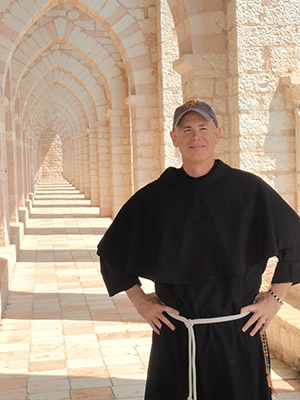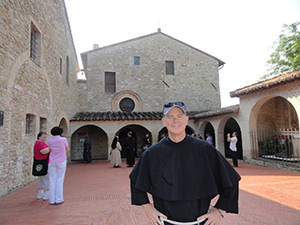John B. Clote has a devotion to what he calls “the sacrament of storytelling.”
 Franciscan Friar John Clote, a former broadcast journalist, is pictured in Assisi, Italy, during production of his recent film, “Purgatory: The Forgotten Church.” (Submitted photo courtesy Friar John Clote)“I just love storytelling,” said the former broadcast journalist, whose career has included stints at NBC News and Relevant Radio. “That’s what Jesus did. He used parables to express these profound truths … that were so powerful that we’re continuing to tell them. The church proclaims them still 2000 years later.”
Franciscan Friar John Clote, a former broadcast journalist, is pictured in Assisi, Italy, during production of his recent film, “Purgatory: The Forgotten Church.” (Submitted photo courtesy Friar John Clote)“I just love storytelling,” said the former broadcast journalist, whose career has included stints at NBC News and Relevant Radio. “That’s what Jesus did. He used parables to express these profound truths … that were so powerful that we’re continuing to tell them. The church proclaims them still 2000 years later.”
Clote has also directed and produced documentary films since the early 1990s on subjects including Venerable Solanus Casey, St. Maximilian Kolbe and St. Maria Goretti. His latest film, “Purgatory: The Forgotten Church,” was released in 2013 by Lightbridge, a ministry of the Conventual Franciscans of Saint Bonaventure.
Clote joined the order in 2008 and became a Franciscan friar; these days, when he’s not making movies, he is serving daily Mass at St. Josaphat Basilica, where he is on staff, or studying for his second master’s degree at Loyola University in Chicago.
Clote anticipates being ordained to the diaconate in April 2015, and to be ordained a Franciscan priest in May 2016.
His ministry as a Franciscan friar might seem like a surprising deviation from his roots in journalism, but Clote says that “it’s just part of my personal faith journey.”
“The truth is something that journalists hopefully ascribe to, and the church makes it its path to proclaim the truth,” he said.
His former colleague, Relevant Radio’s Drew Mariani, agreed.
related story |
“If we can use media in a powerful way to communicate the Gospel, then that’s fantastic,” said Mariani. “It’d be great to see more people with that skill set serving the church in that capacity. I think John’s background would be a blessing in a lot of respects to his mission also of evangelization.”
Clote was born into a Catholic family in St. Louis; he grew up playing football and making short movies with a friend’s home video camera. As a child, he did not anticipate a vocation to the religious life, but his love for animals led him to choose the confirmation name of “Francis,” a decision he now regards as prophetic.
His journalistic career began at the age 19 with an internship at NBC News. Over the next two decades, the University of Missouri Columbia graduate would write and produce content for “20/20,” “48 Hours,” and “Inside Edition.” He produced a music video shown at the TWA dome during Pope John Paul II’s pastoral visit to St. Louis in 1999, and in 2005 went to Rome to cover the pontiff’s funeral and the election of Pope Benedict XVI.
But the secular newsroom is not always a hospitable environment for the Catholic journalist, he discovered. Clote recalled he was often frustrated by the media’s perception of the Catholic Church and its faithful.
“They have a kind of a rabid hatred of the church, and it’s rather disturbing, to be honest,” he said. “You have to wonder where all that comes from. I think it comes from (the fact that) the church is the only public institution that consistently has said that there is such thing as sexual morality, there is such thing as abortion and pro-life, their stance on assisted suicide, on accountability – all of those things.”
When Mariani came to Relevant Radio in 2004, he was looking for a producer – and as a fellow filmmaker, Clote’s work Franciscan Friar John Clote, whose journalistic career includes work for “20/20,” “48 Hours” and “Inside Edition,” is pictured outside the Church of San Damiano near Assisi, Italy, during production of his recent film, “Purgatory: The Forgotten Church.” (Submitted photo courtesy Friar John Clote) stood out to him. Clote produced “The Drew Mariani Show” for a year before being promoted to chief programming officer at the network.
Franciscan Friar John Clote, whose journalistic career includes work for “20/20,” “48 Hours” and “Inside Edition,” is pictured outside the Church of San Damiano near Assisi, Italy, during production of his recent film, “Purgatory: The Forgotten Church.” (Submitted photo courtesy Friar John Clote) stood out to him. Clote produced “The Drew Mariani Show” for a year before being promoted to chief programming officer at the network.
One of the hallmarks of their time working together, said Mariani, was Clote’s persistence in pursuing stories not being covered by the secular media – most memorably the Terry Schiavo story, the legal struggle from 1990 to 2005 involving prolonged life support.
“John actually brought that story to my attention,” said Mariani. “I broadcast live from St. Petersburg, Florida, and really brought that story to the country in a different way than any of my secular counterparts were doing. We were actually ahead of the curve by probably four, five, six months before the story actually picked up and got traction.”
Another way for Clote to explore underexposed topics is filmmaking. He directed his first feature documentary, “Fourteen Flowers of Pardon: The Life and Death of St. Maria Goretti,” in 1994.
“Our life gets so quick and gets so thrown into fast-forward on a daily basis, that even as Catholics … it becomes a challenge to notice the transcendent things, the unseen realities that are occurring around us,” he said. “And so one aspect of filmmaking that I really relish is that it allows me to kind of put the brakes on that and show people … that there’s more going on than meets the eye.”
In 1996, he became one of the last journalists to interview Mother Teresa, spending several hours with her for his film, “Audrey’s Life.” A year later, he would dedicate his film, “Ocean of Mercy,” to Mother Teresa.
“She was simple, she was generous and she was profound,” remembered Clote. “I’m very grateful for that experience because I was sitting there and talking to her and at the same time, in the back of my head, I’m thinking, you know, this woman could pick up the phone and call any president, any prince, any prime minister in the world and get whatever she wants, by the sheer force of who she is and her personality. You have … politicians who spend their whole life trying to get that kind of power and influence.”
Frank di Bugnara, director of photography for “Purgatory: The Forgotten Church,” is not surprised by his friend and colleague’s “integration” of priesthood and filmmaking.
“The notion is certainly not unprecedented, though the marriage of the two is somewhat novel, so it will be interesting to see how John continues to integrate the various aspects of his vocations,” said di Bugnara. “I personally believe there are tremendous gaps in the present-day Catholic’s knowledge of basic Catholic theology, doctrine and fundamental matters of faith.
“There are certain subjects like purgatory that the modern church has somehow collectively decided are too uncomfortable to discuss – so it largely pretends those realities don’t exist. John’s decision to courageously tackle topics like purgatory, and fill in these widespread knowledge gaps, is both needed and critical.”
For Clote, it’s all part of the sacrament of storytelling.
“Stories, like sacraments, are full of rituals and symbols and when they are told properly and effectively, the way Jesus told them, then (a story) has this capacity to create its own space, its own time and meaning, and in that way a story becomes sacrament.”
Removing myths about purgatory
John B. Clote’s latest film, “Purgatory: The Forgotten Church,” tackles an area of doctrine which has become so uncomfortable for modern-day Catholics that it is almost regarded as taboo.
Author and speaker Susan Tassone, who has been writing about purgatory since 2000, appears in the film, and recently discussed common misunderstandings about Catholic theological teachings on purgatory with the Catholic Herald.
■ Myth #1: Purgatory exists as punishment.
Purgatory is not meant to delay heaven, but to prevent hell, said Tassone.
“Purgatory is the masterpiece of God’s mercy. It’s his love that cleanses and purifies us to be able to stand before him,” she said. “Because of our sin and our selfishness, we need purification – not punishment, but purification. We need healing. It’s the beauty of God that ravishes the souls. It’s a loving and healing purgatory.”
■ Myth #2: Purgatory is a place of pain.
Tassone said purgatory can only be seen as painful in the way that any hard work is painful.
“It will be physically and psychologically demanding,” she said. “Anything worthwhile requires pain. But it’s a pain with reward. If you want to lose weight, if you want to stop smoking, if you want to get physically fit – there’s pain, but it’s a sign of progress. No pain, no gain. The souls experience joy because they can no longer sin, they can no longer offend God, and they know they’re saved.”
■ Myth # 3: Souls in purgatory are in despair.
Though they are not yet united perfectly with God, the souls in purgatory “are happy,” said Tassone. “They call it a spiritual fever. They burn for love of God. And now they can’t be with him, so they have this pain of the loss, but they have the joy because they no longer sin, they no longer offend God and they know they’re saved. So until the end of the world they will stay to do whatever God wants. Their will is perfectly lined up with God’s will.”
■ Myth # 4: There’s no need to pray for the souls of those who died a long time ago.
“So let’s say your grandfather, who died years ago, is in heaven, and you continue to pray for him,” said Tassone. “St. Thomas Aquinas calls this ‘accidental glory,’ which means that if your family is in heaven and you continue to pray, your grandfather gets two things: he gets an increase in his intimacy with God and he gets an increase in his intercessory power. So the lesson is: never stop praying for your dead.”
■ Myth #5: Everyone goes to purgatory.
“God doesn’t want us to go to purgatory,” said Tassone. “We’re given the graces to avoid purgatory. The number one way is do the will of God in all things. How? It goes all the way back to prayer, Mass and the sacraments. We have everything we need to go straight home. We’re given the grace to go directly to heaven. Go to adoration. Do many little things. Accept trials. Forgive.”
